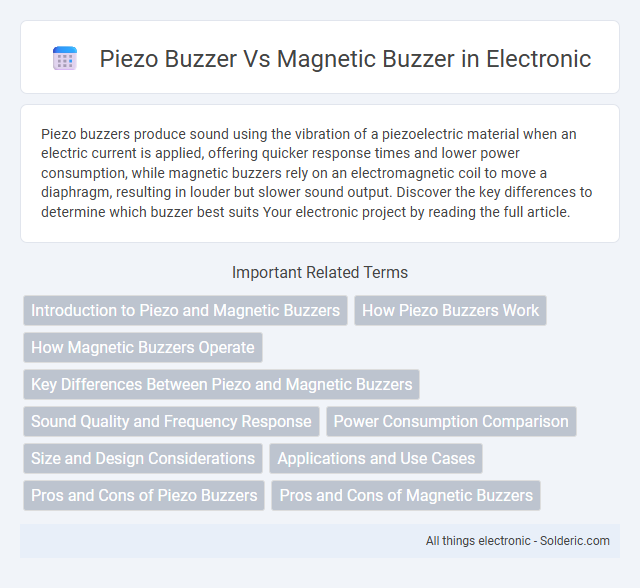Piezo buzzers produce sound using the vibration of a piezoelectric material when an electric current is applied, offering quicker response times and lower power consumption, while magnetic buzzers rely on an electromagnetic coil to move a diaphragm, resulting in louder but slower sound output. Discover the key differences to determine which buzzer best suits Your electronic project by reading the full article.
Comparison Table
| Feature | Piezo Buzzer | Magnetic Buzzer |
|---|---|---|
| Operating Principle | Piezoelectric effect generates sound | Electromagnet vibrates diaphragm |
| Power Consumption | Low power usage (mW range) | Higher power consumption |
| Sound Quality | Clear, sharp tones | Rich, louder sound |
| Frequency Range | Wide, up to 5 kHz or more | Narrower frequency range |
| Size | Compact, thin profile | Generally bulkier |
| Durability | High lifespan, no moving parts | Moderate, has moving mechanical components |
| Cost | Moderate cost | Usually lower cost |
| Typical Applications | Wearables, alarms, timers | Appliances, automotive alerts |
Introduction to Piezo and Magnetic Buzzers
Piezo buzzers generate sound using the piezoelectric effect, where an electric charge causes a ceramic diaphragm to vibrate, producing high-frequency tones with low power consumption. Magnetic buzzers operate through electromagnetic coils that move a metal diaphragm, creating sound waves typically louder and deeper but consuming more energy. Both types serve various applications like alarms, timers, and user interfaces, with piezo buzzers favored for compact, energy-efficient designs and magnetic buzzers preferred for louder, more resonant audio output.
How Piezo Buzzers Work
Piezo buzzers operate using the piezoelectric effect, where an electric voltage applied to a piezoelectric material causes it to deform and produce sound waves. These buzzers generate sound by rapidly deforming a piezoelectric crystal or ceramic disk, creating vibrations that emit high-frequency tones. Your choice of piezo buzzer ensures compact size and efficient power consumption compared to magnetic buzzers, which rely on electromagnetic coils and mechanical diaphragms.
How Magnetic Buzzers Operate
Magnetic buzzers operate by using an electromagnet to create sound through the vibration of a metal diaphragm when electrical current passes through the coil. This vibration generates audible noise, making magnetic buzzers ideal for louder, more resonant alert signals in various devices. Your choice between piezo and magnetic buzzers should consider the magnetic buzzer's ability to produce stronger sound output with simple AC or DC drive circuitry.
Key Differences Between Piezo and Magnetic Buzzers
Piezo buzzers utilize the piezoelectric effect to generate sound through the vibration of a ceramic diaphragm, delivering high-frequency tones with low power consumption and minimal electromagnetic interference. Magnetic buzzers operate using an electromagnet and a diaphragm, producing louder sounds at lower frequencies but consuming more power and being susceptible to electromagnetic noise. Key differences include power efficiency, sound frequency range, size, and susceptibility to interference, making piezo buzzers ideal for compact, low-noise applications and magnetic buzzers better suited for louder output requirements.
Sound Quality and Frequency Response
Piezo buzzers deliver a higher-pitched, clearer tone with a broad frequency response, typically ranging from 2 kHz to 5 kHz, making them ideal for precise alert signals and audio feedback. Magnetic buzzers usually produce a lower-pitched, less sharp sound due to their electromagnetic coil design, with a frequency response generally between 1 kHz and 3 kHz, suited for simple tone generation. The choice between piezo and magnetic buzzers depends on the required sound clarity, pitch, and application-specific audio quality demands.
Power Consumption Comparison
Piezo buzzers typically consume less power than magnetic buzzers due to their efficient piezoelectric materials that generate sound with minimal energy. Magnetic buzzers rely on coils and magnets, which require higher current and voltage, resulting in increased power consumption. Your choice of buzzer should consider these differences to optimize energy efficiency in battery-powered or low-power applications.
Size and Design Considerations
Piezo buzzers are typically smaller and thinner, making them ideal for compact electronic devices where space is limited, while magnetic buzzers are bulkier due to their coil and magnet assembly. The lightweight and flat design of piezo buzzers allows for easier integration into slim panels and circuit boards, whereas magnetic buzzers require more mounting space and can add weight to the end product. Designers select piezo buzzers for applications prioritizing miniaturization and low power consumption, while magnetic buzzers are chosen when louder sound output and robustness are essential.
Applications and Use Cases
Piezo buzzers are widely used in electronic devices requiring low power consumption and high-frequency sound generation, such as alarms, timers, and handheld gadgets. Magnetic buzzers excel in applications needing louder sound output and lower frequency tones, commonly found in industrial equipment, automotive alerts, and larger appliances. Both types serve critical roles in signaling and notification systems across consumer electronics, medical devices, and automotive industries.
Pros and Cons of Piezo Buzzers
Piezo buzzers offer advantages such as low power consumption, high sound output with minimal distortion, and a compact, durable design suitable for various electronic devices. However, piezo buzzers can be more sensitive to environmental conditions like temperature changes and may produce higher-pitched tones that are less effective for certain alert applications. Compared to magnetic buzzers, piezo buzzers generally deliver faster response times but are limited in generating lower frequency sounds.
Pros and Cons of Magnetic Buzzers
Magnetic buzzers offer high sound output and can operate at lower voltages, making them suitable for applications requiring loud alerts in compact spaces. They tend to consume more power and have slower response times compared to piezo buzzers, which may limit their use in battery-powered or fast-switching devices. Your choice should weigh the magnetic buzzer's robust sound capability against these energy and speed considerations.
piezo buzzer vs magnetic buzzer Infographic

 solderic.com
solderic.com